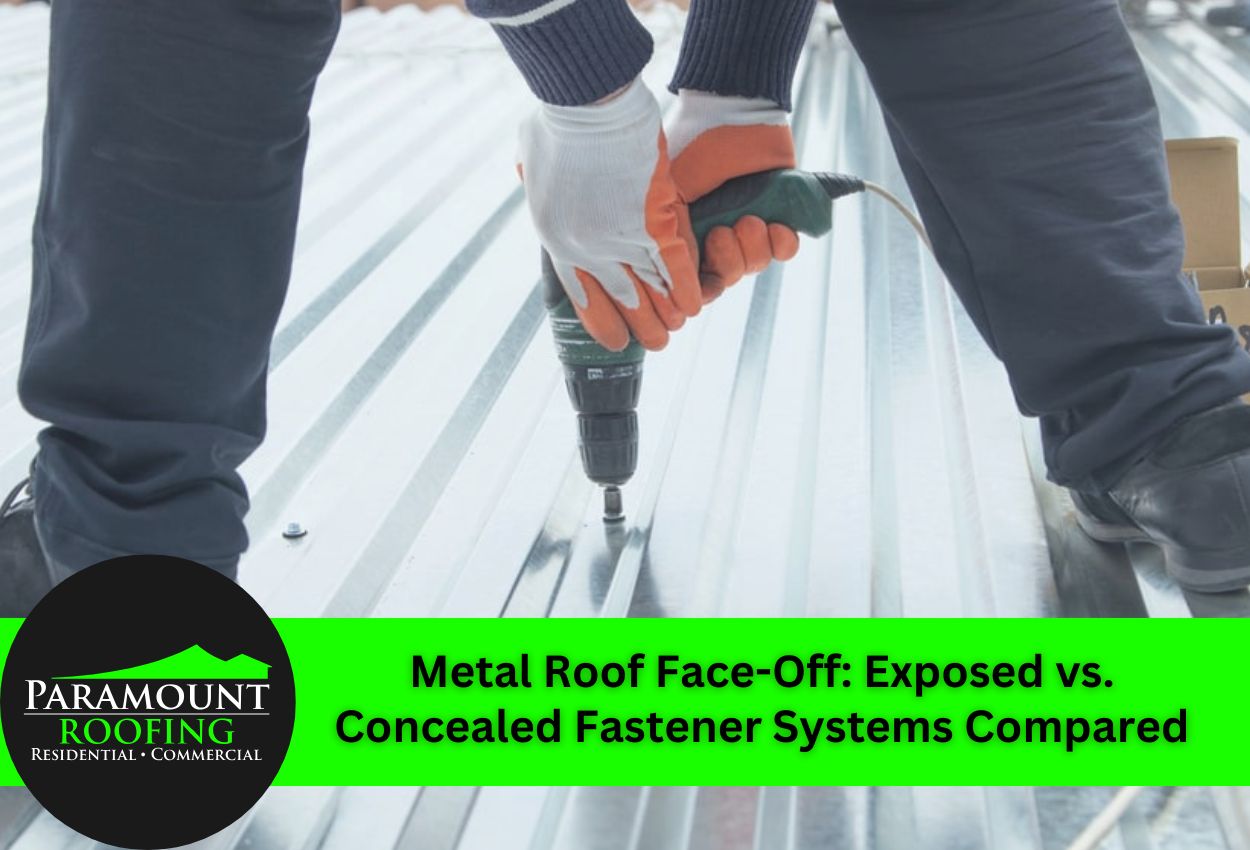Detroit homeowners considering a metal roof face an important decision that impacts both the performance and appearance of their investment: choosing between exposed and concealed fastener systems. This choice affects everything from installation complexity to long-term durability, especially in Michigan’s heavy snowfall and seasonal temperature fluctuations.
Exposed fastener metal roofs, commonly seen in corrugated and R-panel styles, feature screws driven directly through the metal panels into the roof deck. These visible fasteners create a distinctive pattern across the roof surface while securing the panels in place. In contrast, concealed fastener systems, like standing seam metal roofs, utilize hidden clips and interlocking panel edges that completely shield the fasteners from the elements.
The difference between these installation methods includes more than just curb appeal. Concealed fastener systems typically offer superior weather resistance by eliminating potential entry points for moisture, while exposed fastener options generally provide a more affordable solution with simpler installation requirements. For Detroit area homes, this choice has significant implications for how the roof handles ice dams, thermal movement, and seasonal challenges.
Understanding the advantages and limitations of each system helps homeowners select the metal roofing option that best balances their budget, desired appearance, and performance needs in Michigan’s variable climate conditions.
Understanding Metal Roof Fastening Technologies
Metal roof fastening systems determine how your roof will hold up against Detroit’s harsh weather conditions. Exposed and concealed fastening technologies are two common, yet very different, approaches to securing metal panels to your home.
Exposed fastener systems secure metal panels directly to the roof deck or purlins using specialized screws visible on the roof surface. These screws typically feature rubber washers that compress upon installation to create a weather-tight seal. Installation patterns vary, but generally require screws every 12 to 24 inches along panel overlaps and at purlin locations. While this method creates a secure connection, the numerous penetration points require extra attention during installation to prevent leaks.
Concealed fastener systems, including standing seam metal roofs, use hidden clips that attach to the roof deck while allowing panels to interlock and cover the fasteners completely. These clips create a floating attachment system that permits thermal expansion and contraction as temperatures fluctuate between Detroit’s hot summers and freezing winters. This movement can reduce the chances of oil-canning and potential fastener loosening, while the absence of roof penetrations creates superior weather resistance against rain, snow, and ice.
The metal roof panel installation method you choose affects not just immediate weather protection but long-term performance against Michigan’s challenging seasonal transitions, making this a critical decision for Detroit homeowners.
Metal Roof Durability and Longevity in Michigan’s Climate
Michigan’s unpredictable and often harsh weather patterns can test even the strongest metal roofing systems. Understanding how different fastening methods perform in these conditions is essential for Detroit homeowners seeking long-lasting roof protection.
Exposed fastener systems generally face more stress during Michigan’s freeze-thaw cycles. As temperatures fluctuate, metal panels expand and contract, which can gradually loosen fasteners or enlarge screw holes. The heavy snow common in Detroit winters creates downward pressure on these fasteners, potentially compromising their seals over time. Additionally, the rubber washers that protect these penetration points may deteriorate after years of UV exposure and temperature extremes, creating vulnerable entry points for moisture.
Concealed fastener systems demonstrate superior performance in severe Michigan weather conditions. Their clip mounting system allows panels to move independently as temperatures change, reducing stress on attachment points. During the high winds common to Michigan storms, concealed systems provide exceptional uplift resistance because pressure is distributed across numerous hidden clips rather than concentrated at exposed screw points. The absence of penetrations through the panel surface eliminates direct water infiltration paths during winter freeze-thaw cycles and spring thaws.
Detroit roofing contractors often recommend standing seam and other hidden fastener metal roof systems for properties requiring maximum weather resistance and longevity. While initially more expensive than screw-down options, the extended lifespan and reduced maintenance requirements of concealed fastener systems often deliver better long-term value.
Aesthetic Considerations and Property Value Impact
The metal roof you choose will influence both the look and market value of your Detroit home. The aesthetic differences between exposed and concealed fastener systems create entirely different architectural statements.
Exposed fastener panels offer a diverse range of profiles, from traditional corrugated patterns with industrial charm to modern ribbed designs with clean lines. These profiles typically feature regular fastener patterns that become part of the roof’s visual texture. For Detroit neighborhoods with Craftsman, farmhouse, or industrial-inspired architecture, these options can complement existing design elements while still providing the benefits of metal.
Concealed fastener systems present a more premium aesthetic with smooth, uninterrupted surfaces. Standing seam profiles create distinctive vertical lines that draw the eye upward, enhancing the perceived height of homes. In Detroit communities like Palmer Woods or Indian Village, these sophisticated profiles align with historic architectural details while providing modern performance. The clean lines and shadow effects of concealed fastener systems often appeal to potential buyers seeking both refinement and durability.
In general, quality metal roofs can increase property values by up to 6%, with concealed fastener systems typically commanding the higher end of this range. For Detroit homeowners, selecting a metal roof profile that harmonizes with neighborhood aesthetics while showcasing architectural features represents a valuable investment in both curb appeal and resale potential.
Installation Complexity and Maintenance Requirements
The installation process for exposed and concealed fastener metal roofing systems differs in complexity, required expertise, and timeline. Exposed fastener systems are generally more straightforward to install, requiring basic roofing skills and standard tools. A typical installation on an average Detroit home might take a few days with an experienced crew. The process involves overlapping panels and driving screws directly through the material into the roof deck, making it accessible for contractors with general roofing experience.
In contrast, concealed fastener systems require specialized training and precision. Installation typically takes longer for a similar-sized project due to the more complex panel connections and clip systems. Installers need specific tools for seaming and must understand the importance of allowing for thermal movement. For Michigan homeowners, finding qualified contractors with standing seam experience is essential for proper installation.
Long-term maintenance is another significant difference. Exposed fastener roofs require regular inspection of the screws, particularly after Michigan’s harsh winters. Typically, rubber washers need replacement every 10 to 15 years, and periodic retightening or sealant application becomes necessary as the roof ages. Concealed fastener systems eliminate these maintenance concerns, as their hidden attachment points remain protected from UV exposure and weather. This protection is particularly valuable in Detroit’s climate, where freeze-thaw cycles can stress exposed fasteners and potentially compromise their seals over time.
Weather Resistance and Performance Expectations
When comparing metal roofing systems for Michigan homes, weather resistance is a critical factor in long-term performance. Exposed and concealed fastener systems respond quite differently to the various weather challenges Detroit homeowners face throughout the year.
Exposed fastener metal roofs, while less expensive, create multiple potential entry points for moisture with each screw. During Michigan’s heavy rainstorms, these systems rely entirely on rubber washers to prevent leaks. When faced with ice dams, a common winter problem in Detroit, water can back up under panels and find its way through fastener points. Additionally, these systems typically offer moderate hail impact resistance, though fastener points may become vulnerable spots during severe storms.
Concealed fastener systems excel in weather resistance by eliminating penetration points across the roof surface. Standing seam metal roofs create a continuous water barrier, significantly reducing the risk of leaks during heavy precipitation, as the smooth, uninterrupted surface allows snow and ice to slide off more readily. Their superior wind resistance comes from the interlocking panel design that creates a unified surface better equipped to withstand Michigan’s seasonal storms.
Perhaps most importantly for Detroit’s climate, concealed fastener systems easily handle thermal expansion and contraction. With temperature swings from below-freezing winters to hot summers, metal roofs must accommodate significant movement. While exposed fastener systems may restrict this natural expansion if not installed correctly, often leading to loosened screws or distorted panels, concealed systems utilize floating clips that allow panels to move freely with temperature changes, preserving the roof’s integrity across seasons.
Deciding on a Metal Roof for Your Detroit Home
Selecting the ideal metal roof fastening system requires looking at your specific circumstances as a Detroit homeowner. Begin your decision process by evaluating your long-term plans for the property. If you intend to stay in your home for decades, the superior longevity of concealed fastener systems may justify the higher initial investment. For shorter ownership periods, exposed fastener options might provide adequate protection while keeping costs lower.
Your home’s architectural style should significantly influence your choice. Historic Detroit homes often benefit from the clean, sophisticated appearance of standing seam systems, while more traditional or rustic houses might look better with the textured look of exposed fastener panels. Consider how your roof will interact with other exterior elements to create a cohesive appearance.
Michigan’s weather patterns should also influence your decision. Properties in areas with heavy snowfall or frequent high winds generally perform better with concealed fastener systems that resist weather infiltration and provide superior uplift protection. Meanwhile, homes with adequate roof pitch and less extreme exposure may function well with quality exposed fastener installations at a lower price point.
For personalized guidance, discuss your project with experienced Detroit roofing contractors who understand local building requirements and weather challenges. Professional roofers can evaluate your specific property, including roof complexity, attic ventilation, and insulation, to recommend the metal roofing system that delivers the optimal balance of performance, aesthetics, and value for your situation.
Choose Paramount Roofing for Your Metal Roofing Needs in Detroit
Deciding between exposed and concealed fastener metal roofing systems is crucial for protecting your Detroit home. Each system has advantages, whether it’s the moderate cost and simplicity of exposed fasteners or the sleek, durable appeal of concealed fasteners. Understanding these differences can help you make a final choice, impacting not only the performance but also the value of your property.
At Paramount Roofing, we specialize in both exposed and concealed fastener metal roofing installations, made to withstand Michigan’s tough climate while boosting your home’s curb appeal.
Call Paramount Roofing today at (586) 690-0227 to discuss your metal roofing needs with our specialists. Whether you’re leaning towards the robustness of screw-down panels or the sleek finish of a standing seam system, we’re here to help you make the best decision for your Detroit residence.
 Free Estimate
Free Estimate
 Request Service
Request Service Locations
Locations 
